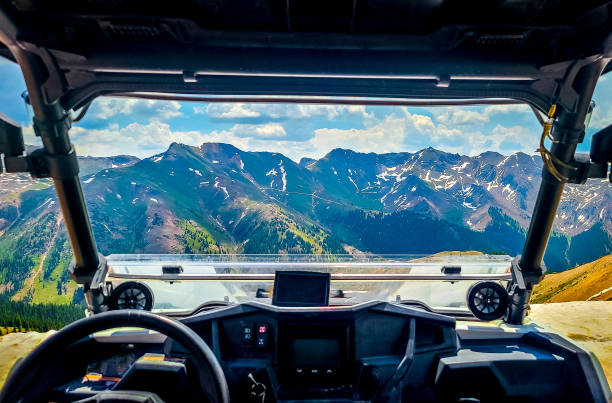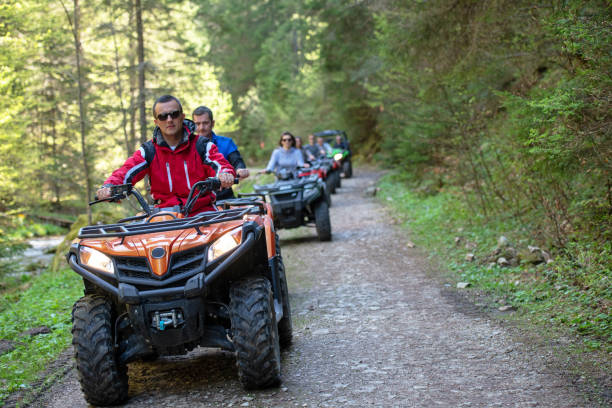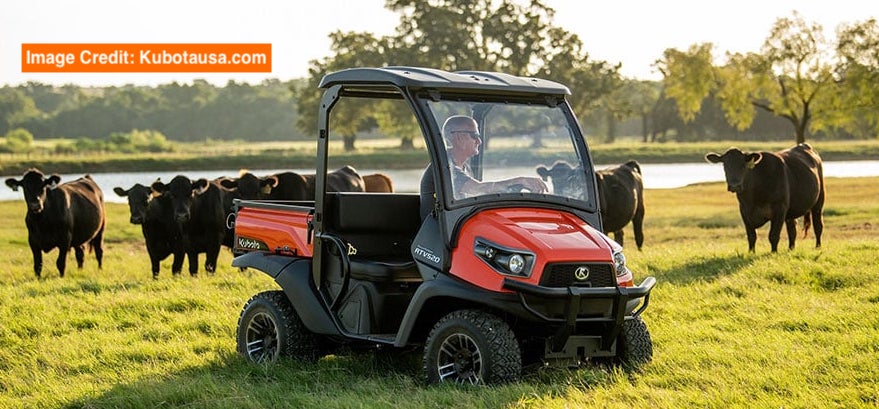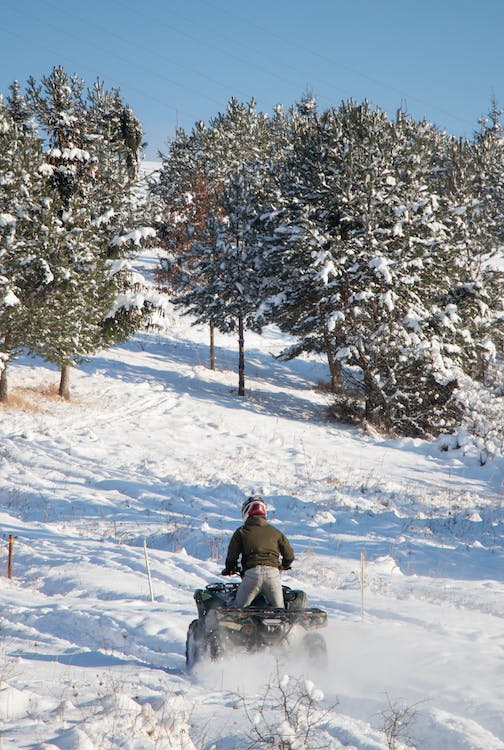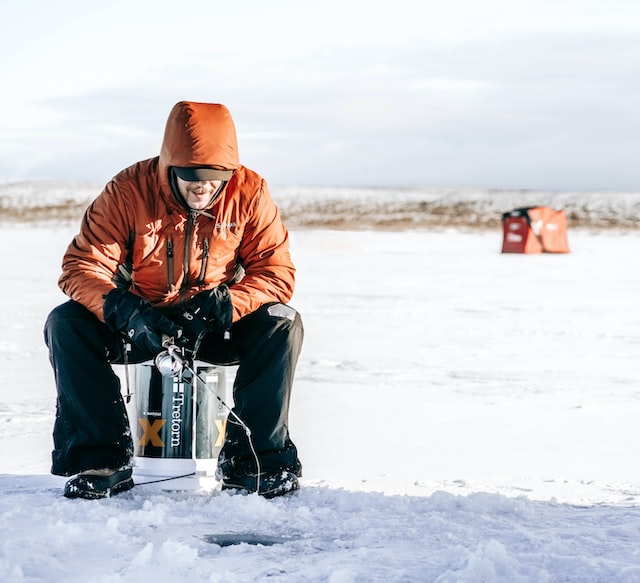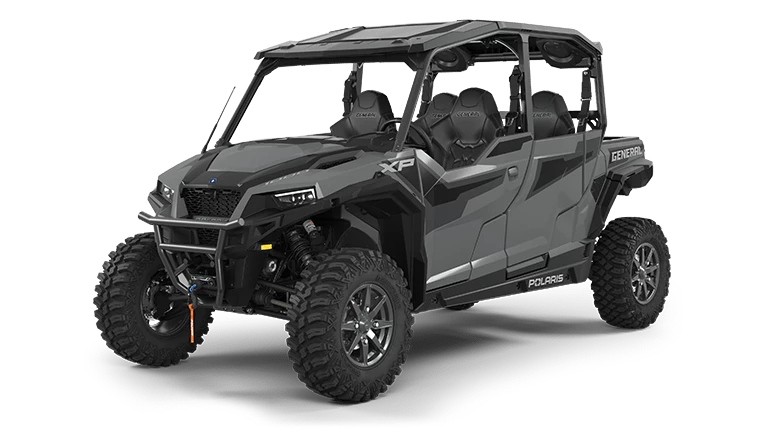As an Amazon Associate I may earn a commission from qualifying purchases at no additional cost to you.
All-terrain vehicles (ATVs) and side-by-side (SxS) vehicles offer thrilling racing opportunities for both novice and seasoned enthusiasts seeking adrenaline-packed competitions.
Various racing events cater to different skill levels and vehicle types, allowing participants to experience the excitement of the sport at their own pace.
From local gatherings to national championships, the racing landscape offers something tailor-made for every off-road lover looking to test their skills.

Organized races often feature diverse terrains, ensuring that every race is a unique challenge.
Racing events might take place on mud trails, rocky paths, or desert dunes, offering varying levels of difficulty and excitement. These events not only highlight the capabilities of the machines but also the driving prowess of their operators.
The variety of terrains ensures that participants continually hone their abilities, contributing to a fulfilling and exhilarating racing experience.
For those curious about racing routes and competitions, numerous forums and online communities provide critical insights and information about upcoming events and opportunities.
Clubs and associations also play a vital role by organizing races and fostering a sense of community among off-road adventurers.
Joining these groups can open doors to exclusive events, tips, and camaraderie, enhancing the overall racing experience.
Understanding ATVs and UTVs
ATVs and UTVs offer different experiences for enthusiasts in terms of mobility, versatility, and competition. It’s crucial to explore their historical development, distinguish their unique features, and understand the factors to consider when choosing the right machine for racing activities.
History and Evolution
ATVs, also known as all-terrain vehicles, originated in the early 1960s as three-wheelers designed for agricultural and recreational use. Honda’s introduction of the ATC90 in 1969 marked a turning point, significantly popularizing these vehicles. Over the years, technological advancements led to the development of four-wheel ATVs for better stability and control.
UTVs, or utility task vehicles, emerged later in the 1980s. Initially intended for work tasks, their design incorporated side-by-side seating, steering wheels, and seat belts, making them popular for both utility and recreation. With time, UTVs evolved to include advanced suspension systems and protective roll cages, enhancing their appeal in competitive racing.
Differentiating ATVs and UTVs
ATVs are typically smaller, lightweight, and designed for individual riders, who use handlebars for steering. These vehicles excel in maneuverability and are favored for their ability to handle tight trails and rough terrains. ATVs usually offer a more active riding style, requiring physical effort and balance from the operator.
On the contrary, UTVs are larger and provide seating for two to six passengers. Equipped with steering wheels and pedal controls, they offer more comfort, stability, and additional storage options. UTVs are often chosen for their ability to transport more gear and people, making them suitable for both utility and recreational applications including racing.
Choosing the Right Vehicle for Racing
Selecting the right vehicle depends on specific racing needs and preferences.
ATVs are ideal for tight trails and courses that require agility and quick handling. Their lighter weight and responsive controls make them suitable for riders seeking a more immediate connection with the terrain.
UTVs, due to their larger frame, are better equipped for endurance races and events that require carrying equipment or additional passengers.
When choosing a vehicle for racing, factors such as terrain type, race length, and personal handling comfort should be considered. Equipment upgrades, driver skill level, and safety features also play a critical role in the decision-making process.
Overview of ATV and Side by Side Racing
ATV and Side by Side racing provide thrilling experiences, attracting enthusiasts with varied race types, formats, and necessary safety protocols. Racing can be a competitive yet safe adventure due to the specific race categories and the importance of understanding respective vehicle classes.
Types of Races
Racing opportunities for ATVs and Side by Sides encompass various formats. Motocross races are popular, with dirt tracks featuring jumps and tight bends. Cross-country races test endurance over natural landscapes with diverse terrains.
Short-course races offer laps on a closed circuit, while hill climbs challenge competitors to ascend steep inclines. Desert races span long distances, emphasizing speed and stamina. Each type caters to different skill levels, from amateur to professional.
Race Formats and Classes
Races are structured around specific formats and classes to ensure fair competition. Formats include time trials, where riders race against the clock, and head-to-head permutations that pit competitors against each other directly.
Classes often categorize vehicles by engine size or modifications. ATVs may compete in classes like Youth, Amateur, and Pro, whereas Side by Sides feature classes such as Stock, Modified, and Turbo. Each class ensures participants compete with similarly equipped vehicles.
Safety and Training
Safety is paramount in ATV and Side by Side racing. Riders must wear protective gear, including helmets, gloves, and body armor.
Races typically mandate safety checks before participation to verify vehicle integrity.
Training is crucial for new and experienced riders. Courses teach essential skills such as cornering techniques and obstacle navigation. Safety courses emphasize maintaining control at high speeds.
Adherence to safety protocols significantly reduces risks, ensuring that the thrilling sport remains a safe experience.
Popular ATV and UTV Racing Series
ATV and UTV racing has carved a niche for itself with various racing series available. These events range from thrilling national championships to exciting international competitions, catering to a diverse community of enthusiasts.
National Championship Series
The AMA ATV Motocross Championship is one of the top choices for ATV riders, featuring multiple classes catering to various skill levels. Enthusiasts can engage in competitions on highly varied tracks across the United States.
Meanwhile, the WORCS (World Off-Road Championship Series) offers a thrilling mix of speed and endurance, primarily tailored for UTV racers. Participants often enjoy a mix of desert and cross-country terrains. A structured season helps participants gauge their progress, offering a comprehensive competition experience.
Regional and Local Series
Regional events, like the Extreme Dirt Track Series, provide a grassroots racing environment, ideal for newcomers and seasoned racers alike. Often held in simpler settings, they offer a welcoming community vibe and allow local talent to shine.
Local series frequently support different racing classes, accommodating a range of vehicle types and skill levels. These events serve as stepping stones for those aiming to compete in larger national contests, offering flexibility and accessibility to all participants.
International Competitions
Internationally, the Baja 500 holds prestige as part of the SCORE Series. It pushes racers through challenging desert terrains, offering a test of skill and endurance. With competitors from around the globe, it’s a reinvigorating challenge for ATV and UTV racers.
The King of the Hammers is another renowned event in the international scene, blending rock crawling with high-speed desert racing. This event takes place in California but draws an international audience due to its unique demands and thrilling atmosphere. Participants face a range of obstacles, making it a comprehensive test for any off-road racer.
Significant Racing Events and Competitions

In the realm of ATV and UTV racing, several notable events stand out due to their challenging courses and competitive environments. These events attract enthusiasts and offer a diverse range of experiences, from rugged terrain to strategic gameplay.
King of the Hammers
King of the Hammers is a renowned off-road racing event in Johnson Valley, California. It combines desert racing with rock crawling, making it extremely demanding. The competition is open to UTVs and features a grueling course that tests endurance and skill.
Participants often face treacherous obstacles, requiring precise navigation. The event draws large crowds and is a spectacle of off-road engineering and pilot expertise. Featuring a week-long schedule, it includes qualifying rounds and main events.
Enthusiasts regard it as a must-see due to its scale and the impressive performance of participating vehicles.
ATV Mud Nationals
ATV Mud Nationals invite riders to experience mudding at its finest. Held in Hillarosa ATV Park in Arkansas, this event focuses on the excitement of riding through muddy environments. It features a variety of challenges, including mud bogging and obstacle courses.
Riders come equipped with specialized gear and tires to tackle the deep mud pits. The event is popular for its festive atmosphere, with live music and vendor exhibits adding to the experience.
Participation requires skill in handling muddy terrain and maintaining vehicle performance under duress. It is a highlight for mud racing enthusiasts looking to test their mettle.
Baja 500
The Baja 500 is a legendary off-road race in Mexico, part of the larger SCORE World Desert Championship series. It spans approximately 500 miles of challenging desert terrain, offering an intense test of speed and strategy for ATVs and UTVs.
Renowned for its difficulty, the course features rugged deserts, mountainous trails, and coastal sections. Competitors must manage vehicle durability while navigating complex routes.
With international participants and a rich history, the event is significant in the off-road racing world, often leading to thrilling competition and high-stakes adventure.
UTV Poker Runs
UTV Poker Runs are unique events combining off-road riding with the luck of a poker game. Participants ride to various checkpoints, collecting playing cards along the way. These runs typically occur over varied terrains, offering a scenic and adventurous route.
Each participant aims to form the best poker hand by the end of the run. The format makes it accessible to riders of different skill levels and offers a less competitive, more leisurely experience compared to traditional races.
Celebrated for their social aspect, Poker Runs provide a relaxed environment to enjoy the camaraderie of fellow UTV enthusiasts.
Preparing for a Race

Getting ready for an ATV or UTV race involves attention to your vehicle, physical and psychological readiness, and organizing essential gear and documents. Here’s a comprehensive breakdown of crucial preparations.
Vehicle Modification and Tuning
Performance tuning is essential for racing success. Modifying an ATV or UTV can enhance speed, agility, and reliability.
Consider high-performance tires and suspension upgrades to handle diverse terrains.
Fine-tuning the engine is also vital; adjusting the air-fuel mixture and upgrading the exhaust system could yield better performance.
Safety modifications are equally important. Install a roll cage for UTVs if not already present.
Quality harnesses and reinforced bumpers can prevent serious injuries.
Regular maintenance, such as changing oil and checking brakes, ensures the vehicle is race-ready and reliable under stress.
Physical and Mental Training
Being physically fit improves endurance and performance. Cardiovascular exercises, like running or cycling, enhance stamina.
Strength training, especially focusing on core muscles, aids in controlling the vehicle over challenging courses.
Mental preparation is crucial. Visualization techniques can enhance concentration and reaction time during races.
Understanding the racecourse prior to competition helps reduce anxiety.
Consistent practice, including mock races, builds familiarity with speed and sharp turns, making competitors more confident.
Race Day Checklist
Proper organization prevents race-day stress. Start with confirming registration details and reviewing race guidelines.
Ensure your vehicle is ready with a final inspection, checking fluids, tire pressure, and fuel levels.
Pack essential gear: Helmet, gloves, and protective clothing.
First-aid kits and toolboxes should be easily accessible. Carry identification and race documents in a secure, waterproof location.
Snacks and hydration sources are vital for maintaining energy and focus throughout the event.
Preparing well provides a structured approach to tackle race day challenges, ensuring participants focus on performance and enjoyment while prioritizing safety.
Brands and Manufacturers
Many reputable brands produce ATVs and UTVs, offering enthusiasts reliable and innovative machines. Notable names in the industry emphasize performance, durability, and cutting-edge technology, providing quality vehicles for both recreational and competitive racing.
Top ATV Brands
Yamaha is known for its robust ATVs with models like the Yamaha YFZ450R, which is popular for its performance on racing tracks.
Honda offers durable and reliable machines such as the Honda TRX250X, known for its consistent engineering and versatility.
Polaris stands out with their focus on innovation and power, featuring models like the Polaris Sportsman 570, which is equipped with advanced suspension systems suitable for rugged terrains.
Kawasaki impresses with their KFX series, offering high-speed capabilities and rugged build.
Can-Am is another leading name, with their aggressive ATVs known for handling challenging trails effectively. Their models are often characterized by strong engines and cutting-edge designs.
Reputable UTV Manufacturers
Can-Am leads with their Maverick series, offering vehicles designed for high performance and advanced handling. This is particularly beneficial for racing enthusiasts who seek competitive edge.
Polaris features the RZR lineup, renowned for their off-road durability and speed, appealing to both racers and casual drivers.
Yamaha delivers quality with the YXZ series, emphasizing precision and reliability.
Honda provides well-engineered options like the Pioneer series, known for their utility and adaptability across different terrains. These brands ensure they meet diverse needs with machines that combine safety, power, and technology.
Building a Community
Community building among ATV and UTV enthusiasts fosters camaraderie, encourages knowledge sharing, and promotes responsible riding. Participation in clubs enhances social connections, while volunteering and advocacy efforts advance the community’s goals and image.
Joining Clubs and Forums
Enthusiasts can connect with like-minded individuals by joining clubs and participating in online forums related to ATVs and UTVs. Clubs often organize events such as group rides and technical workshops, providing members with opportunities to share experiences and learn from each other.
Forums, on the other hand, offer a platform to discuss modifications, troubleshoot issues, and exchange tips. Newcomers benefit by gathering insights from seasoned riders, while experienced individuals find a space to impart their knowledge.
Local meet-ups and regional gatherings are also coordinated through these platforms, fostering stronger relationships within the community.
Volunteering and Event Organization
Active participation in organizing events, such as trail clean-ups or charity rides, strengthens bonds among ATV and UTV enthusiasts. Volunteering for roles like event coordination, trail maintenance, or logistical support amplifies the community’s development.
Engagement in these initiatives demonstrates a commitment to not only the sport but also to preserving riding spaces. Enthusiasts who dedicate their time often notice a personal sense of achievement while enhancing the community’s reputation.
Event organizing enhances leadership skills and resourcefulness, offering valuable experiences beyond the thrill of riding.
Advocacy and Responsible Riding
Promoting advocacy is crucial for sustaining access to trails and maintaining a positive public image for ATV and UTV riders. Riders can advocate for the preservation of trails and development of new riding areas by working with local authorities and organizations.
Emphasizing the importance of responsible riding helps mitigate land damage and noise concerns, addressing common criticisms from non-riders.
Advocacy efforts align with educational campaigns which provide guidance on eco-friendly practices and safety protocols. These initiatives support a sustainable future for riding, ensuring long-term enjoyment of the sport for all enthusiasts.
Advancements and Innovations
In recent years, racing for ATVs and UTVs has witnessed significant technological strides that enhance performance and safety. Looking ahead, the future promises even more exciting developments in areas like automation and sustainability.
Technological Progress in Racing
Enhanced Engine Performance: Modern ATVs and UTVs come equipped with advanced engine technologies that improve speed and efficiency.
Turbochargers and fuel injection systems provide better power delivery, helping racers maintain high speeds on challenging terrains.
Suspension Systems](https://hankmassey.com/aftermarket-atv-suspension-components-vs-side-by-side-performance-upgrades/): Innovative suspension systems are making rides smoother. Adjustable shocks and electronic stability control allow for better handling, reducing the risk of accidents during races.
Materials and Design: Lightweight materials like carbon fiber are increasingly used, reducing weight while maintaining structural integrity. This improves maneuverability and fuel efficiency, key factors in competitive racing environments.
The Future of ATV and UTV Racing
Autonomous Racing Features: There is growing interest in integrating autonomous features such as adaptive cruise control and collision avoidance systems. These advancements enhance safety and allow racers to focus more on strategy.
Eco-Friendly Technologies: As environmental awareness grows, manufacturers are developing electric and hybrid ATVs and UTVs. These sustainable options reduce emissions without compromising performance, aligning the sport with global sustainability goals.
Advanced Data Analytics: Data analytics tools are becoming indispensable in racing. Telemetry systems provide real-time data on vehicle performance, enabling teams to make informed decisions during races. This improves both strategy and outcomes.

